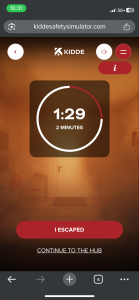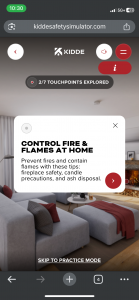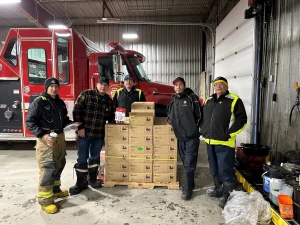In Canada, there are more than 10,000 residential fires every year. And well over 100 deaths.
My friend Albert is not going to be one of them.
He has working smoke alarms and fire extinguishers in pretty much every room in his house. He’s a granddad, so there’s also a family-wise strategy for responding to emergencies, and a home evacuation plan that the whole family has practised.
He’s an outlier, though.
Nearly half of all Canadians do not have a fire escape plan for their home. About a quarter of us have faulty smoke alarms (or we don’t know they need testing and replacement). And more than 100 of us die every year in a home fire.
As we know all too well these days, wildfires are dangerous and deadly.
But it is residential fires that are the leading cause of fire-related death in Canada. Yet many residential fires are preventable and their often-deadly consequences avoidable.
So it’s not surprising we have annual fire safety and awareness campaigns at local, provincial, and national levels. Specific days, weeks, and months are dedicated to raising our fire safety awareness; events and activities will be held across the country and online in the weeks ahead.

The augmented reality (AR) application called Prepare. Plan. Practice. is a digital training tool to make fire safety education more available, useful, and fun. Supplied image.
And in a first-of-its-kind availability, a major international fire safety technology company has developed a digital training tool to make fire safety education more available, useful, and fun.
The augmented reality (AR) application is called Prepare. Plan. Practice. With its animated imagery and on-screen overlays, it’s like an at-home digital fire drill simulator. It augments the experience of a home fire and shows why it’s important to react quickly in a fire emergency with its practice escape demo against a two-minute countdown.
The new app comes from Kidde Canada, and it’s part of the company’s annual global fire safety education initiative, the Cause For Alarm campaign.
Noting that the app was developed in consultation and collaboration with leading Canadian and international fire safety organizations, Stephanie Berzinski, Senior Manager, Communications, Kidde Canada, said the free AR tool works on any connected smartphone or tablet, and does not require a headset or goggles.

The augmented reality (AR) dramatization shows how quickly smoke accumulates and how fast flames spread.
“The fire drill simulator – one of several features in the app – uses AR to show what a fire could look like in your own home,” she described in a phone conversation with WhatsYourTech. “It gives a realistic look at the speed with which smoke can accumulate in a room, and the speed at which flames grow.
“The Prepare. Plan. Practice. app – yes, it’s a mouthful,” she laughed – “helps bring fire safety to life. It’s a pretty eye-opening experience.”
The experience includes two different modes, she noted, starting with the Demonstration Mode of just what a fire would look like in the user’s own home. Using AR technology to put graphic overlays on live video right in the user’s current location, the dramatization shows how quickly smoke accumulates and how fast flames spread; on-screen time scales show the fire’s progress in just two minutes.
It’s a dramatic illustration of the official warnings from fire safety experts that home fires now spread with much greater speed, up to eight times faster than years ago (due in part to different manufacturing materials used).
Most people think they have ten minutes or more to escape but fire experts say the reality is much less: like two minutes!
Once the drill is over, there’s the app’s comprehensive Learn Mode, which lets users explore a digital home and click on hotspots to bring up text-based tips about domestic fire hazards (such as different types of kitchen fires), smoke alarm operations (like gently cleaning or vacuuming the unit, as well as a recommended schedule for battery and full unit replacement), indoor air quality, carbon monoxide safety, and more.
“Our goal was to get as much good information as possible in one place, but not be overwhelming,” Stephanie said. “The relatively critical information is concise and up front. Then, at the end of the AR experience, there’s a safety hub with lots of information, added details, and links to fire safety information, printable safety checklists, escape plan templates and other educational materials.”
She described an intensive and highly collaborative process lasting over a year in developing the app, involving fire safety experts, agency partners, creative media houses, and Kidde staff. (Founded in the U.S. more than 100 years ago, Kidde is now one of the largest makers of fire extinguishers and suppressant systems. The multinational company operates Kidde Canada from Vaughan, Ontario.)
From the very minute details like a colour palette for the app to the big need for realistic-looking AR fires to specific fire and life safety information that will work in two countries (the app will eventually roll out in the U.S.), everyone learned something in the development process, she said.
The fire safety experts working with Kidde on the app were from organizations including the National Fire Protection Association (NFPA), the Fire Marshal’s Public Fire Safety Council, and the Ontario Association of Fire Educators (OAFE), where making safety information as widely available as possible is always a goal.
“This invaluable new tool supports [our] mission by engaging families directly in their homes,” Jamie Kovacs, Executive Director at the Ontario Fire Marshal’s Public Fire Safety Council, said when the app was released. “It’s a powerful way to reinforce what kids learn at school and help close the gap in fire preparedness at home.”
More reinforcement is coming.
As mentioned, several fire safety campaigns and related initiatives will soon be held.
Already underway in London, Ontario, for example, is a door-to-door campaign by city firefighters to make sure there are working smoke alarms in the home (there can be legal fines and penalties if that’s not the case).
In just over a month, on September 28, Ontario will hold its second annual Test Your Fire Alarm Day; it’s a reminder to us all to take a simple, possibly life-saving step – not just this month, but monthly.
Then, in October, there’s Fire Prevention Week from the 5th to the 11th, part

The app was developed in collaboration with several fire safety organizations, including the Ontario Association of Fire Educators, which holds its convention this October.
of an overall Fire Safety Month.
This year’s Fire Prevention Week theme is Charge into Fire Safety, with an emphasis on safety when it comes to using lithium-ion batteries in the home.
Then there’s the Ontario Association of Fire Educators’ (OAFE is one of the groups that worked on the Prepare. Plan. Practice. AR fire safety app) Annual Public Education Conference happening October 21st and 22nd.
And, from October 22nd to the 24th, the Indigenous Public Safety Conference will be held in Calgary.
Plenty of opportunity to get fire safe.
(Coincidentally, almost unbelievably, just as I’m writing this, the high-rise condo building where I live is going through its regular fire system check and safety drill; I have some twenty floors to negotiate as bells ring in my ear. When I get to the lobby, I’ll have something to say to the building safety and fire team that’s assembled there: Thanks!)
# # #
Kidde Makes Fire Apps and Smoke Alarms Available to All Canadians
Kidde’s release of the new AR fire safety app is just part of the company’s annual fire safety campaign, which, like others, underscores the importance of getting fire safety information out there, and especially to kids. The CauseForAlarm.org/Canada online portal includes several fire safety resources, including a children’s book, sing-along song and multilingual toolkit.
Stephanie Berzinski, Senior Manager, Communications, described another Kidde fire safety initiative here in Canada, one that gets not only information out, but hundreds of thousands of dollars worth of smoke alarms into the hands of Indigenous communities across the country.

Cross Lake Nation, Manitoba firefighters preparing to install Kidde smoke alarms as one of the first communities to receive fire safety resources through the Cause For Alarm initiative.
Working with its partners at the National Indigenous Fire Safety Council (NIFSC), and Firefighters Without Borders (FWB), Kidde is contributing nearly $400,000 (CDN) worth of smoke alarms to 16 First Nations communities, she said.
While the need for fire safety awareness is nation-wide, there’s an extra urgent need for enhanced fire safety in Indigenous communities here. A recent report commissioned by the National Indigenous Fire Safety Council (NIFSC) found the rate of death in house fires was around five times higher for Indigenous communities than the rest of the country.
First Nations communities participating in the program will receive smoke alarms, educational resources specific to the communities, and support for installing the devices in the home. The initial phases of the program serve as a pilot project, as more communities may also be served in the future.
So the Indigenous smoke alarm campaign is like the fire safety app’s release: first steps to meet an ongoing need.
“The AR app is a great way to teach people the importance of fire safety, but we think there’s room for growth,” Stephanie Berzinski said. “It’s the first phase, and we’re testing the water to see where it could go, how it could expand.”
Whether sharing safety material in a new digitally engaging way or getting fully functional alarms into the home, the main goal is to help save lives.
-30-



